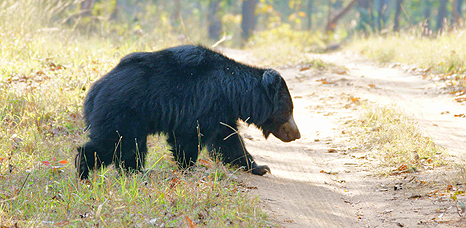Barbara Riddick travelled on our 'Unknown India - Tadoba & Satpura' holiday and submitted this entry to our writing competition.
Sloth Bear, Satpura by Chris Hutchinson
Tadoba & Satpura
The advantage of unknown India is precisely what it says. At Tadoba we enter the park one morning from an even quieter gate than usual. There’s just one other truck (gypsy) with us. It pulls to a halt. Sitting horizontally on the orange sand track ahead of us is a Tigress. We’re so close it’s breathtaking. She sits quite undisturbed, yawns, stretches and shows her pink rasping tongue. This she now uses as she bends her ear with a huge boxing glove of a paw and washes thoroughly behind it. Grooming continues with the systematic intensity of our cat back home. After 15 minutes or so as if in slow motion she rises, saunters off the track and glides out of view through the bamboo thickets.
Our guide reckons she has a kill nearby and that after eating she’ll go to her usual water hole to drink. We track her journey with occasional distant glimpses of orange through the bamboo. Sure enough, she appears across the waterhole but now with blood on her paws which she studiously licks off before rolling over to show her white belly. We watch riveted as a rust-red white-spotted Chital with her fawn makes her unsuspecting way towards the water. The Tigress flattens herself and advances snake-belly style. The Chital suddenly freezes and stamps her right front hoof to tell the Tiger she’s seen her. Phew! The tension dissipates as the Tigress gives up her stalk and returns to repose.
Another sunny afternoon our two ‘gypsies’ are on a quiet side road when we encounter an Indian Wild Dog (Dhole) sitting on a small sand mound beside the track. He’s an even more intense rust-red than the Chital with a smart black brush of a tail. He yawns and stays put, seemingly relaxed despite our proximity. After 10 minutes or so he yelps and whistles to the unseen pack to signal that it’s safe and they emerge one by one behind us: three adults and three cubs - a small splinter pack, says our guide. They play, sniff and zig-zag across the track before finally lolloping away.
When possible our gypsies travel together so we can share the enjoyment. One morning in Pench we’re assigned to different routes. The other group encounters a pack of 14 Dhole playing, resting and grooming before streaking off after a Chital. By serendipity, coming from the other direction, we see the rusty blur of the dogs in pursuit and several minutes later come across the pack on the path, presumably after a failed hunt. Again they’re lounging, socialising, mock-fighting, rolling over, scent-marking, there’s so much activity it’s hard to know which way to look.
Our last stop, Satpura, is the most remote of all. To reach the park in the black and red dawn light you have to take a small ferry across the river; sometimes only three trucks enter the park. Here the ‘stripy one’ is elusive but Sloth Bears abound. Our first sighting is of a large male ripping open termite mounds with long powerful raking claws. The bamboo thickets obscure him to start with but he works his way towards the road and emerges right by us and ambles along it. Over the next few days mothers with cubs (usually twins) are a regular sighting. The most special of all is a mother with two tiny cubs about 10 days old, our guide reckons - the youngest he’s ever seen. These little black powder puffs ride on their mother’s back and make forays on the ground, even scaling a few experimental metres up a sapling.
Another delight are the giant Malabar Squirrels; they’re crimson, cream and russet, surely the most striking squirrels we’ve ever seen. This time of year they’re feeding in trees with long runner bean-like pods. Early one morning we watch a pair hanging down grasping pods and munching away. At lunch time we pass the same tree and the squirrels are now lying flat out along horizontal branches, their tails and paws hanging down; they’re clearly sleeping off their bean feast.
It’s these close encounters over sustained periods of time that make the holiday so very special. By tracking and watching their behaviour with expert guides, ideally without alarming or harassing them, we all feel we have a depth of understanding and pleasure that goes far beyond a simple glance at an animal. By the end of the trip we can recognise the alarm calls of Sambar, Chital and langurs; we’ve been shown the footprints of Tigers, Leopards and Sloth Bears and tracked them with our guides; seen Tiger, porcupine, and Sloth Bear scratching posts and droppings. We have stupendous memories with photographs to preserve them for ever. Catch the peace, solitude and joy of unknown India while you can.
Read more about our 'Unknown India - Tadoba & Satpura' holiday.



 Loading search...
Loading search...
